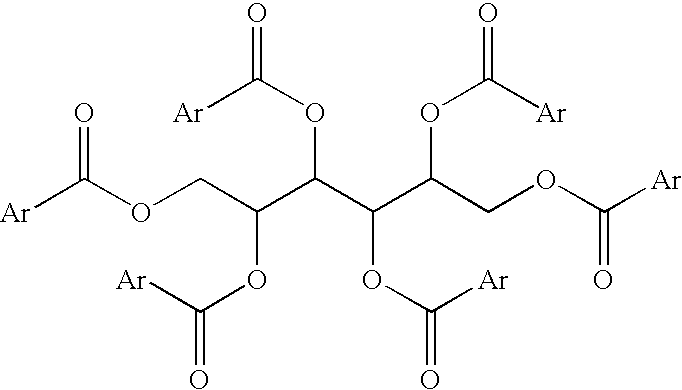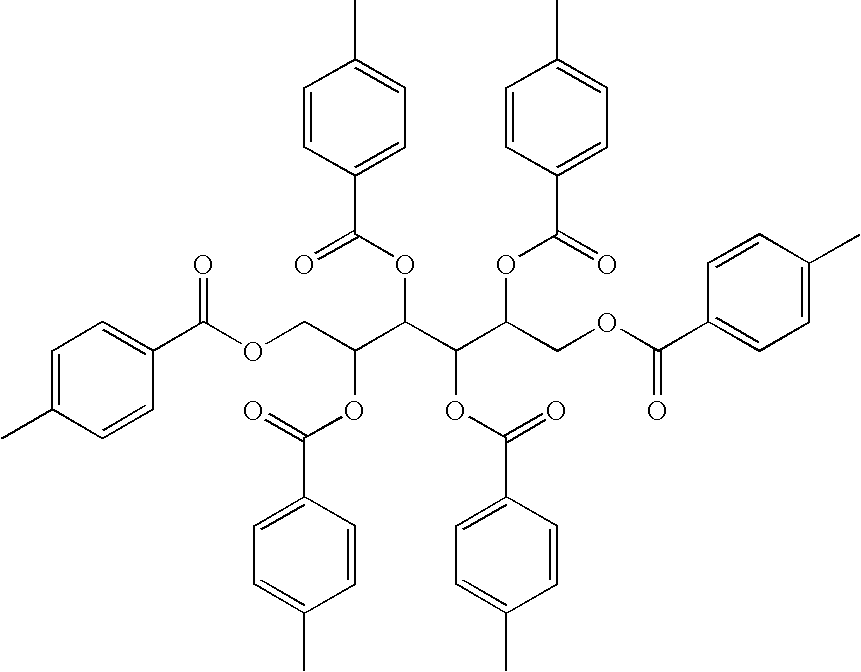Methods of reducing sag in non-aqueous fluids
a non-aqueous fluid and sag reduction technology, applied in the field of particle-containing fluids, can solve the problems of excessive circulation density, sag can occur, and the drilling efficiency to decrease, so as to reduce sag, reduce sag, and increase the viscosity of the fluid composition
- Summary
- Abstract
- Description
- Claims
- Application Information
AI Technical Summary
Benefits of technology
Problems solved by technology
Method used
Image
Examples
example 1
[0022] A sample of hexa-O-para-toluoyl cystol was prepared in accordance with the following procedure. First, 15 g (82.4 mmol) of cystol was added to 84 mL of pyridine, which served as a catalyst as well as the solvent, and stirred to form a suspension. While continuously stirring the suspension, 45.20 mL (494 mmol) of p-toluoyl chloride was added drop-wisely to the suspension for a period of 15 minutes. The resultant light yellow solution was refluxed at 90° C. for 1 hour. The reaction was then quenched with ground ice chips (50 g), and the reaction product was washed twice with 200 mL of an aqueous solution containing 44 wt.% hydrochloric acid (HCl) per total weight of the solution, and then twice with 200 mL of distilled water to remove the pyridine. The cystol ester compound was then extracted from the reaction product by contacting it with 200 mL of dichloromethane, followed by evaporation of the dichloromethane and drying of the resultant cystol ester compound under vacuum. Th...
example 2
[0023] A sample of hexa-O-benzoyl cystol was prepared in accordance with the procedure described in Example 1 except that the amount of pridine used was 100 mL and the p-toluoyl chloride was replayed with 58 ml of benzoyl chloride. The hexa-O-benzoyl cystol is represented by the following formula:
example 3
[0024] A sample of hexa-O-para-tert-butylbenzoyl cystol was prepared in accordance with the procedure described in Example 1 except that the amount of pyridine used was 100 mL and the p-toluoyl chloride was replaced with 90 mL of p-t-benzoyl chloride. The hexa-O-para-tert-butylbenzoyl cystol is represented by the following formula:
PUM
 Login to View More
Login to View More Abstract
Description
Claims
Application Information
 Login to View More
Login to View More - R&D
- Intellectual Property
- Life Sciences
- Materials
- Tech Scout
- Unparalleled Data Quality
- Higher Quality Content
- 60% Fewer Hallucinations
Browse by: Latest US Patents, China's latest patents, Technical Efficacy Thesaurus, Application Domain, Technology Topic, Popular Technical Reports.
© 2025 PatSnap. All rights reserved.Legal|Privacy policy|Modern Slavery Act Transparency Statement|Sitemap|About US| Contact US: help@patsnap.com



